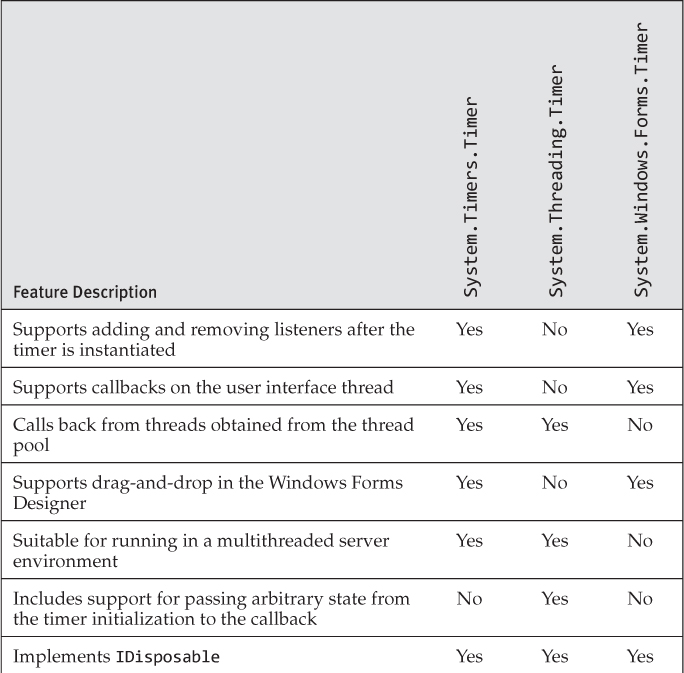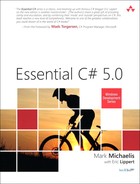D. Timers Prior to the Async/Await Pattern of C# 5.0
Chapter 19 introduced the use of Task.Delay() when a timer was required. For scenarios prior to .NET 4.5, several timer classes are available, including System.Windows.Forms.Timer, System.Timers.Timer, and System.Threading.Timer.
The development team designed System.Windows.Forms.Timer specifically for use within a rich client user interface. Programmers can drag it onto a form as a nonvisual control and regulate the behavior from within the Properties window. Most importantly, it will always safely fire an event from a thread that can interact with the user interface.
The other two timers are very similar. System.Timers.Timer is a wrapper for System.Threading.Timer, abstracting and layering on functionality. Specifically, System.Threading.Timer does not derive from System.ComponentModel.Component, and therefore, you cannot use it as a component within a component container, something that implements System.ComponentModel.IContainer. Another difference is that System.Threading.Timer enables the passing of state, an object parameter, from the call to start the timer and then into the call that fires the timer notification. The remaining differences simply concern API usability, with System.Timers.Timer supporting a synchronization object and having calls that are slightly more intuitive. Both System.Timers.Timer and System.Threading.Timer are designed for use in server-type processes, but System.Timers.Timer includes a synchronization object to allow it to interact with the UI. Furthermore, both timers use the system thread pool. Table D.1 provides an overall comparison of the various timers.
Table D.1. Overview of the Various Timer Characteristics


Using System.Windows.Forms.Timer is a relatively obvious choice for user interface programming with Windows Forms. The only caution is that a long-running operation on the user interface thread may delay the arrival of a timer’s expiration.1 Choosing between the other two options is less obvious, and generally, the difference between the two is insignificant. If hosting within an IContainer is necessary, System.Timers.Timer is the right choice. However, if no specific System.Timers.Timer feature is required, choose System.Threading.Timer by default, simply because it is a slightly lighter-weight implementation.
1. In theory, a similar delay is possible with timers that depend on a thread pool as well because the thread pool may already be busy.
Listing D.1 and Listing D.2 provide sample code for using System.Timers.Timer and System.Threading.Timer, respectively. Their code is very similar, including the fact that both support instantiation within a using statement because both support IDispose. The output for both listings is identical, and it appears in Output D.1. The purpose of each is to display a timestamp in association with a counting value indicating the number of times the timer fired. Once complete, the output verifies that the timer thread is not the same as the Main thread along with the final value of the count.
Listing D.1. Using System.Timers.Timer
using System;
using System.Timers;
using System.Threading;
// Because Timer exists in both the System.Timers and
// System.Threading namespaces, you disambiguate "Timer"
// using an alias directive.
class UsingSystemTimersTimer
{
private static int _Count=0;
private static readonly ManualResetEvent _ResetEvent =
new ManualResetEvent(false);
private static int _AlarmThreadId;
public static void Main()
{
{
// Initialize Timer
timer.AutoReset = true;
timer.Interval = 1000;
timer.Elapsed +=
new ElapsedEventHandler(Alarm);
timer.Start();
// Wait for Alarm to fire for the 10th time.
_ResetEvent.WaitOne();
}
// Is different from the thread executing Main
if(_AlarmThreadId ==
Thread.CurrentThread.ManagedThreadId)
{
throw new ApplicationException(
"Thread Ids are the same.");
}
if(_Count < 9)
{
throw new ApplicationException(
" _Count < 9");
};
Console.WriteLine(
"(Alarm Thread Id) {0} != {1} (Main Thread Id)",
_AlarmThreadId,
Thread.CurrentThread.ManagedThreadId);
Console.WriteLine(
"Final Count = {0}", _Count);
}
object sender, ElapsedEventArgs eventArgs)
{
_Count++;
Console.WriteLine("{0}:- {1}",
_Count);
if (_Count >= 9)
{
_AlarmThreadId =
Thread.CurrentThread.ManagedThreadId;
_ResetEvent.Set();
}
}
}
In Listing D.1, you have using directives for both System.Threading and System.Timers. This makes the Timer type ambiguous. Therefore, use an alias to explicitly associate Timer with System.Timers.Timer.
One noteworthy characteristic of System.Threading.Timer is that it takes the callback delegate and interval within the constructor.
Listing D.2. Using System.Threading.Timer
using System;
using System.Threading;
class UsingSystemThreadingTimer
{
private static int _Count=0;
private static readonly AutoResetEvent _ResetEvent =
new AutoResetEvent(false);
private static int _AlarmThreadId;
public static void Main()
{
using( Timer timer =
new Timer(Alarm, null, 0, 1000) )
{
// Wait for Alarm to fire for the 10th time.
_ResetEvent.WaitOne();
}
// Verify that the thread executing the alarm
// Is different from the thread executing Main
if(_AlarmThreadId ==
Thread.CurrentThread.ManagedThreadId)
{
throw new ApplicationException(
"Thread Ids are the same.");
}
if(_Count < 9)
{
throw new ApplicationException(
" _Count < 9");
};
Console.WriteLine(
"(Alarm Thread Id) {0} != {1} (Main Thread Id)",
_AlarmThreadId,
Thread.CurrentThread.ManagedThreadId);
Console.WriteLine(
"Final Count = {0}", _Count);
}
{
_Count++;
Console.WriteLine("{0}:- {1}",
_Count);
if (_Count >= 9)
{
_AlarmThreadId =
Thread.CurrentThread.ManagedThreadId;
_ResetEvent.Set();
}
}
}
12:19:36 AM:- 1
12:19:37 AM:- 2
12:19:38 AM:- 3
12:19:39 AM:- 4
12:19:40 AM:- 5
12:19:41 AM:- 6
12:19:42 AM:- 7
12:19:43 AM:- 8
12:19:44 AM:- 9
(Alarm Thread Id) 4 != 1 (Main Thread Id)
Final Count = 9
You can change the interval or time due after instantiation on System.Threading.Timer via the Change() method. However, you cannot change the callback listeners after instantiation. Instead, you must create a new instance.
